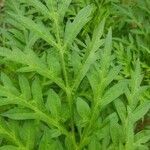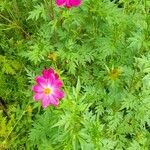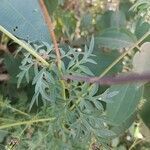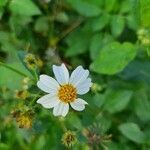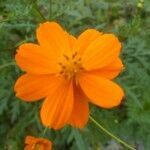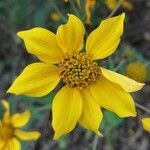Annual, single-stemmed, branched, 20–70 (–200) cm high, glabrous or sparsely hispid, aromatic. Leaves subdeltoid in outline, 3–4-pinnate or-pinnatipartite; petiole thin, 10–70 mm long; lamina 4–20 cm long, 3–15 cm wide; leaflets or ultimate lobes lanceolate or oblong-lanceolate, 2–10 mm wide, acuminate and acute, glabrous, with ciliate margins. Capitula radiate, 1–3 in terminal clusters, on thin, subglabrous peduncles 5–20 cm long; outer involucral bracts herbaceous, linear-lanceolate, 6–9 mm long, acuminate and acute, glabrous, ciliate at margins; inner involucral bracts narrowly oblong, 7–10 mm long, with hyaline margins, acute, usually pink; paleae narrowly oblong. Ray florets c. 8; ligule 10–15 mm long, usually pink to purplish or rarely white. Disc florets 7–8 mm long, yellow. Achenes fusiform-tetragonal, often curved, 10–30 (–35) mm long, with elongated hispid beak, glabrous or scabrid at base. Pappus awns 2 or 3, barbed, with barbs usually spreading or reflexed.
Plants 30–250 cm, glabrous or sparsely hispid. Leaves: petioles 1–7 cm; blades 10–20 cm, ultimate lobes 2–10 mm wide, margins spinulose-ciliate, apices acute, often mucronulate. Peduncles 10–30 cm. Calyculi of usually spreading, linear-subulate bractlets 6–10 mm, apices acuminate. Involucres 5–15 mm diam. Phyllaries erect, oblong-lanceolate, 7–11 mm, apices acute to obtuse. Ray corollas rose-pink to purple, laminae oblong-oblanceolate, 5–15 mm, apices obtusely 3-lobed. Disc corollas 5–6 mm. Cypselae 12–35 mm, glabrous or scabridulous proximally, setose distally; pappi of 2–3 widely divergent to reflexed awns 3–5 mm. 2n = 48.
An erect annual herb. It grows 0.5-2 m high. The stem has sparse hairs. The leaves are divided 2 or 3 times. They are 5-15 cm long with a leaf stalk 7 cm long. The upper segments of the leaf are oblong and 1.5-3.5 cm long by 3-6 mm wide. There is one flower head. It is 1-1.5 cm long and 5 mm wide. The dry fruit is 2-2.6 cm long.
